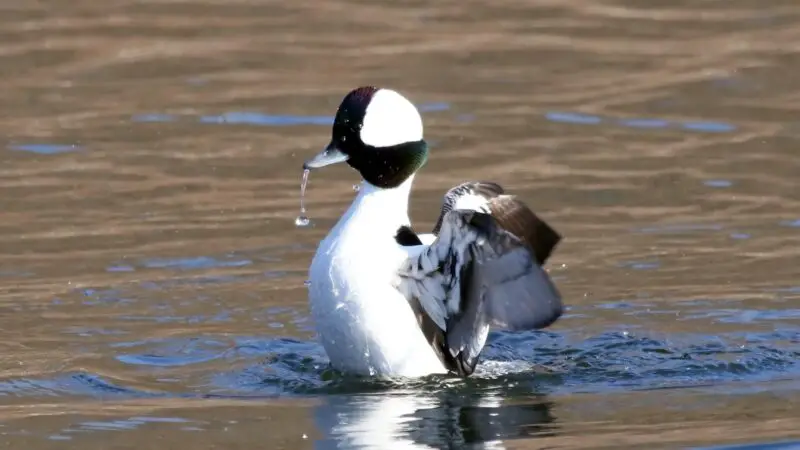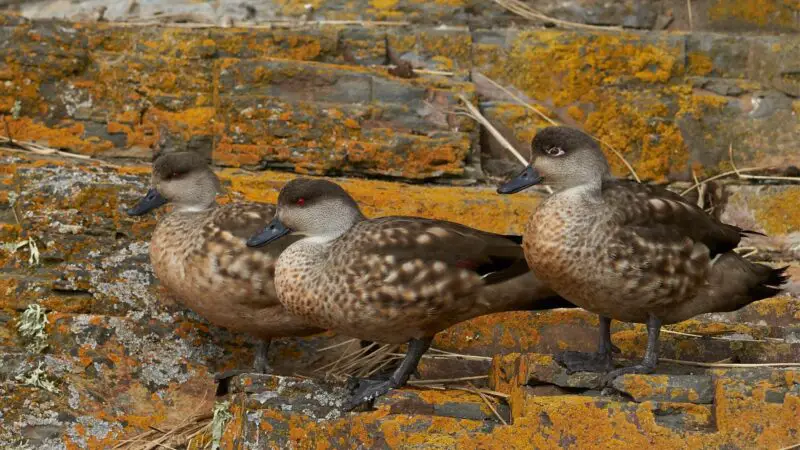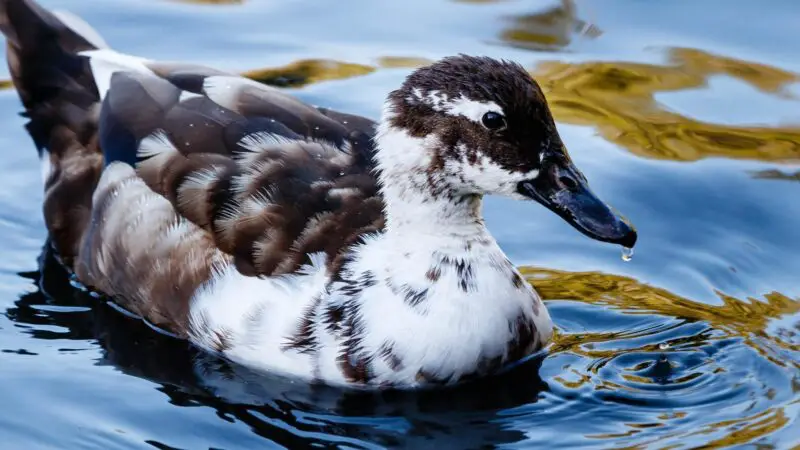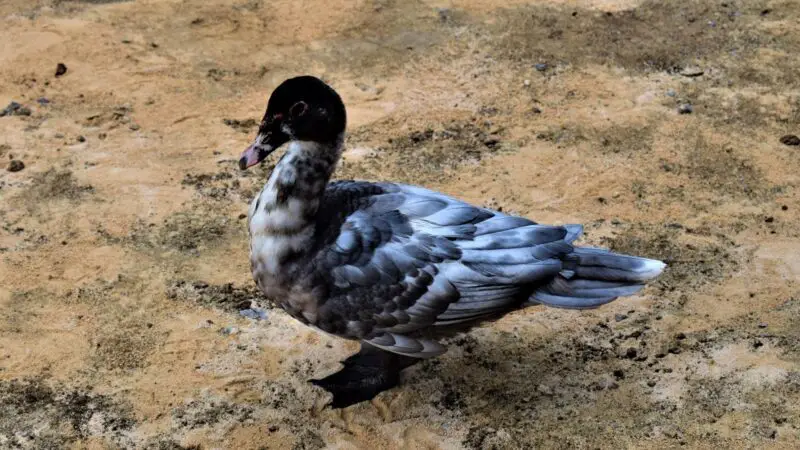If you’re thinking of growing some ducks in your backyard or farm, the beautiful black and white duck breeds are one of your great options. Most species of this breed are excellent great layers of top quality meat.
What are the various black and white duck breeds? Some of the black and white duck breeds that you can choose from are Greater Scaup, Crested duck, Bufflehead duck, Magpie duck, etc. These breeds are good egg layers, making them ideal to raise.
By reading this guide, you’ll know more about the different characteristics of these breeds, which will help you determine if they’re the right breed for you. So, let’s start!
8 Beautiful Black and White Duck Breeds
Greater Scaup

The Greater Scaup is a diving duck with a rounded head and is medium-sized. This duck species breed across the regions of tundras in Europe and North America.
They gather by hundreds, if not thousands during winter, along the Atlantic and Pacific coasts. In the species of the greater scaup, the head of the adult male is not peaked or angular but rounded.
It also has a green sheen with a bluish bill and hard-to-find black nail—much broader than those of the lesser scaup. They also have a white streak on their wings, extending into the primaries.
Meanwhile, the females of this species are brown with white markings around the base of their bill that give them a white face.
In terms of diet, the Greater Scaup feeds on aquatic invertebrates such as mollusks, insects, crustaceans, aquatic plants, and seeds.
- Appearance: Greater scaup has a dark, iridescent round head and bluish beak. They are medium in size, and adults in their second year possess yellow eyes.
- Lifespan: 18 years
- Height: 39 to 56 cm tall (adult)
- Weight: 1.601 to 2.998 pounds (adult)
- Wingspan: 71 cm to 84 cm (adult)
- Place Of Origin: Alaska
- Characteristics: Greater Scaup has a black breast and rump, white flanks, and a barred grayish back. It has a bluish bill and a dark iridescent head.
Bufflehead Duck

The Bufflehead is the smallest sea duck that came from North America. Its name is a direct reference to its large head.
These ducks are beautiful and fly with a swift wing beat. They usually fly near the water but don’t create a whistling sound when in flight.
It’s also best to note that females are less colorful than males. Adult males are primarily black with green and purple iridescent shine in them.
In addition, they have white underbelly with a big white patch on their heads, starting at the top to their neck’s bottom. Their bills are also blue-grey with pinkish webbed feet.
On the other hand, females have a brown top and grey bottom. The sides of their heads also have a white patch with dark grey to black bills.
These ducks primarily feed on marine insects—especially crustaceans. They also consume mollusks, such as snails, during winter and a small portion of plant material during fall.
- Appearance: The body of an adult male Bufflehead is white with a black back, dark head, and a large white patch wrapping around the back of its head. Meanwhile, females are grayish-brown with an oval, white patch on their cheek.
- Lifespan: 2.5 years (average)
- Height: 32 cm to 40 cm long (adult)
- Weight: 270 g to 550 g (adult)
- Wingspan: 55 cm
- Place Of Origin: North America
- Characteristics: Bufflehead swims lively and dives more smoothly than other duck breeds. They start flying by running a short stretch on the surface and usually fly higher over land and low over the water surface.
Crested Duck

Crested ducks are domestic waterfowl species, weighing roughly over two to seven pounds for mature males and two to six pounds for adult females. In some cases, males have a more prominent crest than female crested ducks.
These ducks can fly at a speed of up to 95 km/hour for short distances. They’re dual-purpose, which means they are raised for their meat and egg production.
These ducks are also deemed as dabbling ducks—meaning they love to go through silt, mud, and gravel to look for macroinvertebrates. This includes kelp, clams, zooplankton, and other macroinvertebrates.
- Appearance: Crested ducks have a large crest, centered on top of their crowns. They have medium-sized bodies, long, arched necks, and full breasts.
- Lifespan: 20 years
- Height: 50 cm to 60 cm
- Weight: 7 pounds for males and 6 pounds for females
- Wingspan: 57 cm
- Place Of Origin: East Indies
- Characteristics: Thys duck breed has distinguished features like its straight, medium-sized necks. Their legs and beaks are lengthy with pale orange color. On top of that, their heads are covered by a thick crown crest that looks like an afro.
Tufted Duck

Tufted ducks are diving ducks that are medium size with black heads, necks, breasts, and black and white sides. They have yellow eyes and a small crest with prominent white stripes on their wings that can be seen during flight.
These ducks are omnivores and primarily feed on mollusks, crayfish, crustaceans, aquatic insects, and snails. They also eat seeds and aquatic plants’ buds and roots.
- Appearance: Tufted ducks have large heads and short bodies. The males have golden-yellow eyes, black plumage, white flanks, and gray-blue bills. Meanwhile, the females have pale flanks and are brown in color.
- Lifespan: 4 years on average
- Height: 43.2 cm for males and 43.2 cm for females
- Weight: 889.6 g for males and 768.3 g for females
- Wingspan: 20.2 to 21.2 cm males and 19.4 to 20.7 cm females
- Place Of Origin: Northern Eurasia
- Characteristics: Tufted ducks are medium in size. They have a black neck, head, breast, and black and white sides. On top of that, their eyes are yellow with a prominent white stripe on their wing’s back that can only be seen in flight.
Magpie Duck

The Magpie is a British duck breed with a long body wide head, and a long yellow or orange beak. Standard types of this species comprise blacks and blues.
These ducks have limited capabilities since their wings are small to lift themselves. They’re farmed for their meat, eggs, and even exhibition.
Nonetheless, they are excellent show birds and are fantastic egg layers. Their meat is also known to be of top quality and very tasty. Their remarkable foraging capabilities and calm and friendly nature make them perfect pets for first-time duck owners.
Magpies’ diet involves layer feed, waterfowl feed, and chick starters that are not medicated.
- Appearance: The Magpie ducks appear like wearing small flat caps over their heads due to the black feathers sitting on their heads, looking like little caps. Furthermore, they have long bodies, broadheads, and long yellow or orange beaks, comprising blacks and blues species.
- Lifespan: 9 to 12 years
- Height: 1 meter high
- Weight: 2.7 kg for males and 2.5 for females
- Wingspan: 88 inches
- Place Of Origin: United Kingdom
- Characteristics: The first thing you’ll notice when you see magpies are their broadheads with black feathers that look like caps. On top of that, their bodies are long with long orange or yellow bills.
Ancona Duck

Ancona ducks may have derived from either the United States or Great Britain in the early 1900s. Similar to Magpie ducks, they are assumed to have descended from the Indian Runner ducks or Huttegem.
Ancona ducks have two-toned plumage—which is black and white. Most of their feathers are white, but you can see black patches on their cheeks, cap, face, back, wings, sides, and shoulders.
In addition, their feet and beaks are yellow with black patches on them. This breed has particularly cared for their meat and eggs since they can lay up to 210 to 280 white eggs each year.
Their eggs can also be tan, blue, cream, or spotted. You’ll seldom see these ducks flying or wandering far from their home. They are excellent foragers, and their diet includes seeds, worms, grasses, and bugs.
- Appearance: Anacona ducks are stout species with pinto-style patterns, unique for each duck. They usually come in blue and white, black and white, lavender and white, silver and white, chocolate and white, and multicolored.
- Lifespan: 10 years on average
- Height: Medium
- Weight: 2.3 to 2.9 kg (adult)
- Wingspan: 73 inches
- Place Of Origin: United States/United Kingdom
- Characteristics: The Ancona ducks are medium in size, weighing around 2.3 kg to 2.9 kg. They have slightly indented bills with oval heads and rare, broken colored white patches on their plumage.
Pomeranian Duck

Pomeranian ducks got their name from their country of origin—Pomerania, Germany. They are crossbreed and share the same ancestry as Swedish blue ducks and Shetland ducks, which are quite rare.
These ducks are commonly found in poultries, gardens, and farms across Northeastern Europe, particularly between Sweden and Germany.
They have black plumage with a green sheen and a white patch around their breasts. Furthermore, their beaks are black, and they have dark brown eyes.
They are usually kept as pets and for their eggs and meat. This is not surprising since they can deliver 70 to 100 blue or white eggs each year.
These ducks feed on different types of bugs, rice bran, slugs, and snails. Most of these species live for 4 to 8 years on average, but others have lived for more than 10 years.
- Appearance: The Pomeranian ducks have traditional blue or black bodies and white breasts. They are medium in size with deep brown eyes, and black feet and beaks.
- Lifespan: 4 to 8 years
- Height: Medium
- Weight: 3 kg for males and 2.5 kg for females
- Wingspan: Unknown
- Place Of Origin: Germany
- Characteristics: Pomeranian ducks have chunky bodies with colored back parts and heart-shaped shoulders. In addition, they have dark heads with green iridescent heads and white plumage underneath their bills.
Muscovy Duck
Muscovy ducks are among the oldest domesticated waterfowl species in the world. They can be found in Argentina, Southern Texas, Northern Mexico, and lowland regions.
Males are the largest duck species in North America. They have black feathers and some white markings on their wings.
Their black feathers have green radiance, while their faces bear some red warts. They also have dark gray feet and bills. Meanwhile, the female Muscovy ducks own large bodies and are primarily black in color.
Their wings have white patches, along with feet and bills. On top of that, their necks are long, and they feed on diverse plants and animals.
Part of their diet includes reptiles, grasses, spiders, insect larvae, seeds, tubers, and sedges. They are primarily raised for their meat, but many farmers keep them at their disposal to push away mice and snakes.
These ducks can lay 8 to 15 eggs just in one nesting on average.
- Appearance: This breed is large with heavy bodies and long necks, making them appear like small geese. They have relatively long bills with long tails.
- Lifespan: 20 years
- Height: 66 cm to 84 cm
- Weight: 1.1 kg to 4.1 kg
- Wingspan: 137 cm to 152 cm
- Place Of Origin: South America
- Characteristics: Muscovy ducks are a highly intelligent breed, but can be occasionally aggressive.
Frequently Questions
What Is the Prettiest Duck Breed?
According to the Living with Birds website, the Mandarin duck is the prettiest duck breed. It comprises various colors, such as vibrant purple, blue, white, and orange tint.
On top of that, Mandarin duck has a purple crest on the back of their heads with greenish to black foreheads. Both sides of their heads are creamy-white with a chestnut patch under their eyes.
In addition, the sides of their cheeks and necks have much longer brown feathers. Their upper breast is colored maroon, with a white belly and lower chest.
What Is the Rarest Duck?
The Madagascar pochard is an incredibly rare breed of diving duck. They were assumed as extinct in the late 1990s.
However, the species’ specimens were rediscovered at Lake Matsaborimena—close to Madagascar’s Bemanevika, in 2006. In 2017, a breeding program took the initiative to care for the species and produced approximately 90 individuals.
Then, around December 2018, the birds were reintroduced to the wild. The Madagascar pochard diet primarily includes aquatic insects, and their ducklings start making short dives, as early as 14 days old, before feeding on the surface.
What Is the Friendliest Duck?
The Pekins ducks are among the friendliest ducks in the world. They’re typically known for their gentle and friendly nature around humans, making them good pets, and are usually raised for their eggs and meat.
These birds are stunning with their downy white plumage and a slight yellow tint. They have yellowish-orange bills, orange feet and legs, long necks, and stubby wings, which isn’t ideal for long flights.
Pekins ducks can be great companions since they are sweet. However, they can also be very loud, so they are only ideal for rural homesteads, not suburban sites.
What Is the Most Colorful Duck?
The most beautiful and colorful duck is the Mandarin duck. It is known for its brilliant coloring of vibrant purple, orange, blue and white colors.
Its forehead has a greenish-black iridescent with an attractive purple crest close to its head’s back.
Summary
So, there you have it! These are the beautiful black and white duck species you may want to consider raising near your home or farm.
If you’re considering raising some ducks, ensure choosing the right breed for you and your neighborhood. This is because there are duck species that are just too noisy or too aggressive for you to handle.
Kindly refer to the guide above to help you choose the right breed for you.
Related: 16 Black and White Duck Breeds | All You Need to Know!
List of Sources
Confusing Domestic Ducks (And hybrids)
The Status and Ecology of the Last Wild Population of Madagascar Pochard Aythya Innotata
